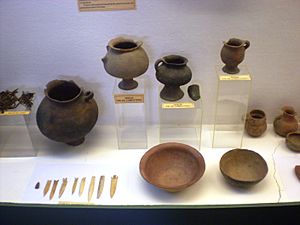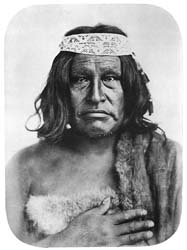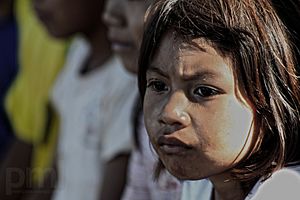Indigenous peoples in Argentina facts for kids

Distribution of the indigenous peoples in present-day Argentina
|
|
| Total population | |
|---|---|
| 955,032 (2010) 2.38% of the total Argentine population |
|
| Regions with significant populations | |
| Argentine Northwest, Patagonia | |
| Languages | |
| Spanish • Indigenous languages (including Guaraní, Qom, Wichí, Quechua, Mapudungun) |
Argentina is home to 35 indigenous people groups, also known as Native Argentines. These groups are officially recognized by the national government. In 2010, about 955,032 Argentines, which is 2.38% of the country's population, said they were indigenous or had indigenous parents.
Some of the largest indigenous groups include the Aonikenk, Kolla, Qom, Wichí, Diaguita, Mocoví, Huarpe, Mapuche, and Guarani. Many Argentines also have at least one indigenous ancestor. A study in 2011 showed that over 56% of Argentines tested had an indigenous ancestor on one side of their family. About 11% had indigenous ancestors on both sides.
The Jujuy Province in northwest Argentina has the most households (15%) with an indigenous person or their direct descendant. Chubut and Neuquén Province in Patagonia also have over 12% of such households.
Contents
History of Indigenous Peoples
Ancient Times

The oldest signs of indigenous peoples in Argentina date back to 11,000 BC. These were found at the Piedra Museo site in Santa Cruz Province. The Cueva de las Manos (Cave of the Hands), also in Santa Cruz, is over 10,000 years old. These sites are among the oldest proofs of indigenous culture in the Americas. They show that people lived in the southern part of the Americas much earlier than some scientists first thought.
After European Arrival
By the year 1500, many different indigenous groups lived in the area that is now Argentina. They were not one big group but many separate ones. Each had its own language, way of life, and relationships with other groups. Because of this, they reacted differently when the Spanish arrived. The Spanish often looked down on the indigenous people. They thought indigenous people were not as good as them, so they didn't write down much about their history.

In the 1800s, big changes happened in Patagonia. Between 1820 and 1850, the original Aonikenk people were pushed out of their lands by invading Mapuche groups. By 1870, much of northern Patagonia was settled by Mapuche people.
During the late 1800s, the Argentine government strongly encouraged people from Europe to move to Argentina. The idea was to settle empty lands and help the country grow. This led to the saying, "Argentines descend from ships." Argentina received the second-highest number of immigrants in the world, with 6.6 million people. Only the United States received more.
As European communities and railways expanded into the Pampas and Patagonia, there were conflicts with indigenous tribes. This led to the Conquest of the Desert in the 1870s, where over 1,300 indigenous people died. After this, indigenous cultures in Argentina were often ignored or made invisible by the government.
In the 20th century, researchers like Juan Bautista Ambrosetti helped bring more attention to indigenous people. Their contributions to Argentina's culture were highlighted, especially in the 1940s and 1950s. Laws against discrimination were passed, like the Antidiscrimination Law in 1988. The National Institute Against Discrimination (INADI) was created in 1995. In 2004, Corrientes Province made Guaraní an official language alongside Spanish. By 2010, all 35 native peoples were recognized in the national census.
Indigenous Communities Today
Current Demographics

In 2010, about 955,032 Argentines identified as indigenous or as first-generation descendants. This was about 2.38% of the country's population.
The first government survey to count indigenous people was in 2001. A more detailed survey in 2004 found 600,329 people who identified as indigenous. However, indigenous groups questioned these numbers. They said the survey didn't fully count people in cities. Also, many indigenous people hid their identity because they feared being treated unfairly. When the survey was designed, it only knew of 18 indigenous groups. Today, over 31 groups are recognized. This shows that more indigenous people are now openly identifying with their heritage.
Many Argentines wrongly believe that most indigenous people have died out or blended into Western society. Because of this, negative words are sometimes used to describe indigenous people. These stereotypes have forced many indigenous people to hide who they are to avoid discrimination.
As of 2011, many native people were still fighting for their land and human rights. For example, the Qom community struggled to protect their ancestral lands. Their leader, Félix Díaz, said his people were denied medical help and clean drinking water. He also claimed that local businesses unfairly raised food prices for them.
The National Institute for Indigenous Affairs (INAI) works to protect indigenous rights and lands. In 2018, INAI had records of 1,653 indigenous communities. Of these, 1,456 had legal ownership of their lands.
Genetic Ancestry in Argentina
Genetic ancestry of Argentines (matrilineal). European Contribution (52.9%) Indigenous Contribution (39.6%) African Contribution (7.5%)
Beyond those who identify as indigenous, many Argentines have some indigenous ancestors. Studies show that Argentina's genetic makeup is mostly European, but also has significant indigenous and some African roots.
One study of 441 Argentines found that, on average, 65% of their genes were European, 31% indigenous, and 4% African. However, these percentages varied a lot across the country. For example, in the Northwest, people were about 66% indigenous and 33% European. In central areas like Buenos Aires, people were mostly European (76%), with 17% indigenous and 7% African ancestry.
Another study showed that Argentines as a whole were about 38% indigenous, 58.9% European, and 3.1% African. Again, there were big regional differences. People from Patagonia were 45% indigenous and 55% European. In the Northwest, they were 69% indigenous and 23% European.
Indigenous Groups by Population
According to the 2010 census, here are the main indigenous groups and their populations:
| Indigenous group | Total population | Males | Females |
|---|---|---|---|
| Mapuche | 205,009 | 103,253 | 101,756 |
| Toba | 126,967 | 63,772 | 63,195 |
| Guaraní | 105,907 | 53,788 | 52,119 |
| Diaguita | 67,410 | 34,295 | 33,115 |
| Kolla | 65,066 | 32,553 | 32,513 |
| Quechua | 55,493 | 27,849 | 27,644 |
| Wichí | 50,419 | 25,513 | 24,906 |
| Comechingón | 34,546 | 17,077 | 17,469 |
| Huarpe | 34,279 | 17,098 | 17,181 |
| Tehuelche | 27,813 | 13,948 | 13,865 |
| Mocoví | 22,439 | 11,498 | 10,941 |
| Pampa | 22,020 | 10,596 | 11,424 |
| Aymara | 20,822 | 10,540 | 10,282 |
| Avá Guaraní | 17,899 | 9,438 | 8,461 |
| Rankulche | 14,860 | 7,411 | 7,449 |
| Charrúa | 14,649 | 7,192 | 7,457 |
| Atacama | 13,936 | 7,095 | 6,841 |
| Mbya-Guaraní | 7,379 | 3,872 | 3,507 |
| Omaguaca | 6,873 | 3,551 | 3,322 |
| Pilagá | 5,137 | 2,623 | 2,514 |
| Tonocote | 4,853 | 2,437 | 2,416 |
| Lulé | 3,721 | 1,918 | 1,803 |
| Tupí Guaraní | 3,715 | 1,872 | 1,843 |
| Querandí | 3,658 | 1,776 | 1,882 |
| Chané | 3,034 | 1,559 | 1,475 |
| Sanavirón | 2,871 | 1,399 | 1,472 |
| Ona | 2,761 | 1,383 | 1,378 |
| Chorote | 2,270 | 1,177 | 1,093 |
| Maimará | 1,899 | 876 | 1,023 |
| Chulupi | 1,100 | 537 | 563 |
| Vilela | 519 | 279 | 240 |
| Tapiete | 407 | 217 | 189 |
| Others | 5,301 | 2,681 | 2,620 |
| Total | 955,032 | 481,074 | 473,958 |
Indigenous Groups by Region
Northeast Argentina
This region includes the provinces of Chaco, Corrientes, Entre Ríos, Formosa, Misiones, Santa Fe, and parts of Santiago del Estero Province.
- Charrúa
- Lule
- Mbya-Guaraní
- Mocoví
- Pilagá
- Qom
- Tonocoté
- Vilela
- Wichí
Northwest Argentina
This region includes the provinces of Catamarca, Jujuy, La Rioja, Salta, San Juan, parts of Santiago del Estero Province, and Tucumán.
- Atacama
- Avá-Guaraní
- Chané
- Chorote
- Chulupí
- Diaguita-Calchaquí
- Kolla
- Ocloya
- Omaguaca
- Tapiete
- Qom
- Wichí
- Quechua
Central Argentina
This region includes the Autonomous City of Buenos Aires and the provinces of Buenos Aires, Córdoba, La Pampa, Mendoza, and San Luis.
- Atacama
- Avá Guaraní
- Comechingon
- Diaguita-Calchaquí
- Huarpe
- Kolla
- Mapuche
- Het
- Rankulche
Southern Argentina
This region includes the provinces of Chubut, Neuquén, Río Negro, Santa Cruz, and Tierra del Fuego.
See also
 In Spanish: Pueblos indígenas de Argentina para niños
In Spanish: Pueblos indígenas de Argentina para niños
- Indigenous peoples of South America
- Languages of Argentina
- Argentine people
- Abipón people
- Amaicha
- Calchaquí
- Capayán
- Poya people


